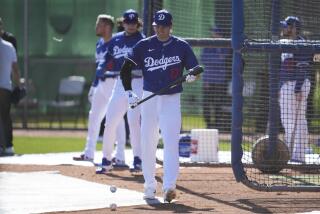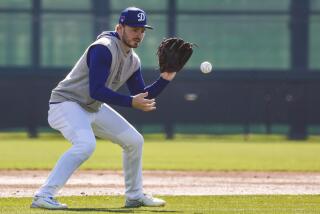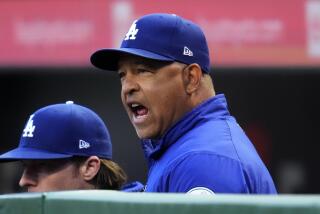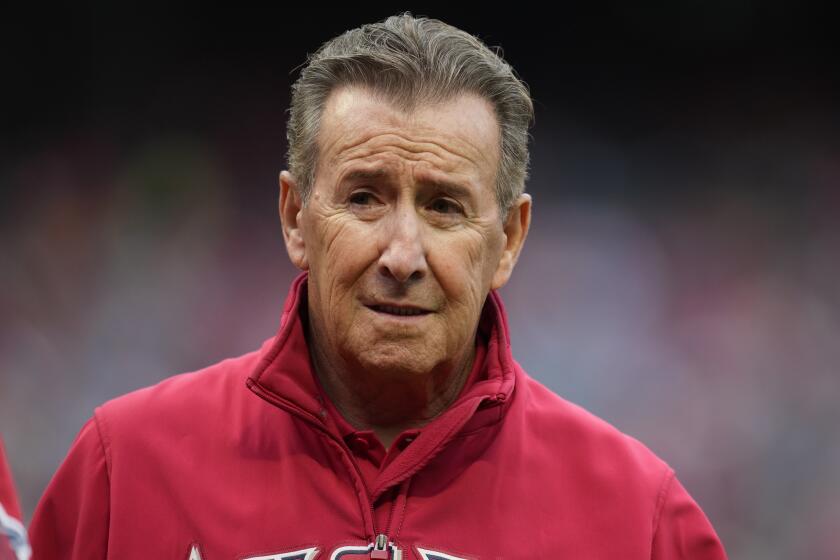Body of Work
Del Mar â Steve Finley had just completed a fourth season in San Diego and was about to turn 34 the winter of 1998-99. The Padres, figuring the outfielder was nearing the end of his career, offered him a two-year contract plus an option year, with an opportunity to move into the front office when the deal was done.
âTo do what?â Finley asked, recalling his reaction to then-Padre President Larry Lucchinoâs front-office overture. âI planned on playing a lot more than that.â
Six seasons, 166 home runs, 162 doubles, 34 triples, 525 runs batted in, three Gold Glove Awards, one World Series ring and four postseason appearances later, Finley has shown no slippage. He turns 40 on March 12 and signed a two-year, $14-million deal with an option for a third year with the Angels in December.
In recalling those negotiations six winters ago, Padre General Manager Kevin Towers said, âWe werenât trying to insinuate his career was finished. We all adored Steve and just wanted him to know that whenever he was done playing, there would be a place for him here.â
Finley, though, felt slighted enough to phone Arizona owner Jerry Colangelo, then, within 24 hours of the call, sign a four-year, $23.6-million deal with the Diamondbacks, helping them win National League West titles in 1999, 2001 and 2002 and the World Series in 2001.
After a trade to the Dodgers last July, Finley helped them win the NL West title. This season, heâll team with Vladimir Guerrero and Garret Anderson to give the Angels one of baseballâs best outfields.
And the Padres? Well, theyâre not expecting Finley to come knocking on their front-office door any time soon.
âItâs remarkable what heâs done since [leaving San Diego]; heâs only gotten better,â Towers said. âHe looks the same now as he did when he played for us in 1996. He still runs real well and hits for power. [His hair] hasnât gotten gray. His skin looks good.... Heâs the Dick Clark of baseball -- he never seems to age.â
*
An ordinary workout, this is not.
Itâs an abdominal-blasting, spine-tingling, mind-boggling array of exercises, a routine that blends resistance training with elements of yoga and martial arts, requires keen balance and an occasional contortionist twist, and includes a once-a-week dip for some high-intensity water aerobics.
Welcome to Cirque du Finley.
To understand how the new Angel center fielder feels stronger and more limber as he approaches 40 than he did at 30 or 35; why he has been every bit as productive in the five years after his 35th birthday as he was in the five years before; and why he won a Gold Glove last season at an age when most outfielders have retired, one must spend a morning with Finley and his training and fitness consultant, Edythe Heus, at Finleyâs Del Mar beach house, where a two-car garage has been converted to a gym.
While the waves of the Pacific lap the shore a mere 50 yards away, Finley is grunting and grimacing through a workout that is grueling to merely watch.
But the usual soundtrack -- blocks of iron clanging together, weight machines churning -- is absent. Most of the workout is conducted with a big, bouncy exercise ball and a collection of hand weights, ranging from eight to 16 pounds, that also fit on Finleyâs feet. The most Finley lifts during the workout? Thirty-five pounds.
âWhen I first started doing this, I kept asking Edythe, âWhen am I going to start lifting heavier weights?â â said Finley, a 16-year veteran. âThe answer is never.â
That was in the winter of 1998-99, when Finley, a former Southern Illinois physiology major who has always been open to new training ideas, gave Heusâ ProBodX -- Proper Body Exercise -- program a try.
Heus, a Dana Point chiropractor, developed ProBodX as a way to retrain the nervous system to be more efficient, to get all the muscle groups of the body working in unison for optimal performance. There is a heavy focus on the spine and abdominals, and balance and flexibility are incorporated in virtually every exercise.
âYouâre not training individual muscles, youâre working the body from the inside out,â Heus, 49, said. âThe concentration is far less on muscle and more on movement, function.â
Finley remembers being unsure of the program that first winter, and though he felt great, he left for spring training with Arizona in 1999 âhaving no clue what to expect.â
Then he stepped into the batting cage, âand the ball was going another 30 feet off my bat with the same swing,â said Finley, who bats left-handed. âI was hitting balls way out of left field and center field with ease. I called Edythe, and it was like, âYou did it! Iâm hooked!â â
Finley had hit .249 with 14 homers and 67 RBIs in 1998. After one winter of ProBodX, he hit .264 with 34 homers and 103 RBIs in 1999.
*
Finley begins his workout by standing on one leg on a small 30-degree slant board, doing knee bends with a 10-pound ball and then tossing the ball back and forth with Heus, first with two hands, then one. All while on one leg.
Much of Finleyâs routine is done on unstable surfaces, such as the slant board or the exercise ball, to âactivate the nervous system at a deeper level,â Heus said. âMost peopleâs workouts are push-pull, and youâre really not challenging your nervous system; youâre just working your big muscles.â
The theory behind âout-of-balanceâ training is, the more effort you put into balancing, the more difficult -- and the more beneficial -- the weightlifting and stretching become.
âWhen Iâm not balanced, Iâm having to correct my abs,â Finley said as he teetered on the slant board. âUp and down my spine, Iâm getting all kinds of corrections, even down to my feet. It makes your body more aware of where it is in space.â
Next is a series of exercises with the big ball, some with his stomach on the ball and some with his back on the ball; some with weights in his hands, some with weights on his feet; some during which heâs stationary, some during which he twists his torso on the ball; some during which he twirls his arms around; some during which he twirls his legs around.
âIt almost looks like a choreographed dance,â Heus said.
Then again ... performing âopen-knee lifts,â Finley lies face down with his torso on the ball, his knees splayed out with a 12-pound ball between his feet, and thrusts his legs up and down.
âThatâs torture for most people,â Heus said.
Maybe he has a masochistic side, because Finley canât seem to get enough of it.
âThis is so much better than anything Iâve done,â Finley said. âMy body starts craving this, and I think thatâs my nervous system talking to me. It loves the feeling it gets from this workout. And I love the feeling of bouncing out of bed in the morning all year long.â
Finley moves on to a âSupercat,â which looks like a squat machine with a slant-board surface. He stands with each foot on a balance disk -- think of a large plate with a ball underneath -- and then does a number of overhead squats, each with one hand. It looks like some kind of circus act -- until Finleyâs body starts quivering after three or four repetitions and the degree of difficulty becomes clear.
âYouâve never had so much trouble lifting 35 pounds in your life,â Finley said.
On a gluteus-hamstring (glute-ham) machine, Finleyâs body is suspended a few feet above the floor, his feet locked under a bar behind him, an exercise ball wedged between his torso and the apparatus, his arms hanging in front of him.
He lifts a pair of 12-pound weights, one in each hand, but Heus doesnât let Finley rest as he brings them down. She provides resistance, so that Finley has to work to lift the weights up and to push them back down.
Though the exercise seems geared to the arms and shoulders, the exercise ball forces Finley to work the abdominals. He strains his glutes, calves and thighs to remain on the apparatus. The more you watch, the more apparent it becomes that in every exercise, Finley is working virtually every muscle group in his body, from head to toe.
âThis isnât a baseball workout -- itâs a become-a-better-athlete workout,â Finley said. âIt helps everything you do. Itâs more of a lifestyle workout.â
For his finale, Finley returns to the Supercat for âthrow-offs.â Lying on his back on the slanted board, with his feet under the bars normally reserved for shoulders, he lifts the bar and a 35-pound weight, one leg at a time, with such force the bar flies a foot or so into the air.
âShe puts you in positions where muscle groups have to work together ... and it keeps your body functioning at a higher level,â Finley said. âYou do it and you start understanding it, and things start clicking in. All of a sudden, you can start doing things with your body that you couldnât do before.â
Finley does the 75-minute workout in his garage twice a week. He mixes in speed and agility workouts -- there is no distance running -- with Brazilian runner Joaquim Cruz, who won the gold medal in the 800 meters at the 1984 Olympics.
And once a week, Finley does a ProBodX-like workout in the pool of his home in nearby Rancho Santa Fe.
âItâs all this stuff in the water,â Finley said. âThereâs resistance in both directions. Itâs high-intensity with no stress on the joints.â
*
The beauty of the workout, Finley said, is that itâs performance-enhancing and therapeutic. He reaps benefits on offense, defense and the basepaths.
Combined with an eating plan that follows principles of the Zone Diet, the 6-foot-2, 194-pound Finley feels more energetic, more refreshed, all season long.
âWith six weeks of spring training and 162 games, if your body is not functioning efficiently, at some point youâre going to have a breakdown,â Finley said.
Instead, Finley feels strong at the end of the season -- he hit .337 with five homers and 25 RBIs for the Dodgers in August, and though he dipped to .195 in September, he hit six homers and had 16 RBIs in the final month, including a dramatic, division-clinching, walk-off grand slam against San Francisco on Oct. 2.
And Finley is convinced there is a correlation between his workouts and his not having been on the disabled list since 1997, even though he ran into a wall in the summer of 2000 and suffering a bulged nerve in his lower back, an injury that required surgery after that season.
âA couple of years ago, I thought I was going to pull a hamstring for sure, so I called Edythe and told her sheâs got to meet me in L.A.,â Finley said. âShe came and did some muscle tests and figured out my lower abs werenât even working.
âShe gave me some exercises to get them firing again and within three or four days, my hamstring problem was gone. Sheâs my miracle worker. Her specialty is ... I call it search and destroy. She gets to the root of the problem, so the symptom goes away.â
The toughest thing about ProBodX, Finley said, is explaining it to fellow players. When he first did his routine at spring training in 1999, âGuys were looking at me like, âWhat ... are you doing?â â Finley said.
Several teammates have tried it, but Finley knows of only two other big leaguers -- infielder Mark Grudzielanek and reliever Mike Koplove -- who follow the program. Heus has written a book -- called âProBodXâ -- and Finley plans to help her market the program by producing an exercise video next winter.
âIâm an old-school guy with a new-school mentality,â Finley said. âWhen youâre young, you can get away with lots of things, but as you get older, youâre muscles are more imbalanced, and itâs going to catch up with you.
âI found a workout that maximizes my potential, and I would say I feel stronger now than I did five, 10 years ago. I feel like Iâve found a fountain of youth.â
More to Read
Go beyond the scoreboard
Get the latest on L.A.'s teams in the daily Sports Report newsletter.
You may occasionally receive promotional content from the Los Angeles Times.








